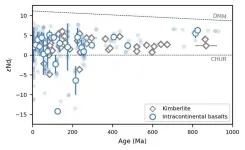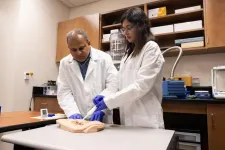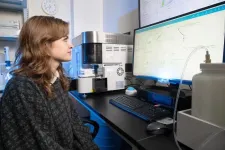(Press-News.org) A collaborative effort between investigators at the National Institutes of Health’s National Institute of Allergy and Infectious Diseases (NIAID) and Massachusetts General Hospital (MGH), a founding member of the Mass General Brigham healthcare system, demonstrates the potential of precise genome editing technologies, called adenine base editors, to correct disease-causing mutations in stem cells from patients with X-linked chronic granulomatous disease (X-CGD), a rare genetic disorder characterized by high susceptibility to infections. The findings are published in Science Translational Medicine.
Patients with X-CGD experience recurrent invasive infections, hyperinflammation and inflammatory bowel disease, with increased morbidity and early mortality. The research team sought to optimize gene editing approaches to correct X-CGD mutations and develop a safe and effective treatment for the condition.
The study, which was led by co-first authors Vera Bzhilyanskaya, a postbaccalaureate fellow at NIAID, and postdoctoral research fellow Linyuan Ma, PhD, at MGH, was borne out of a longstanding collaboration between the laboratories of Suk See De Ravin, MD, PhD, a senior research physician and chief of the Gene Therapy Development Unit at the NIAID, and Benjamin Kleinstiver, PhD, an investigator at the Center for Genomic Medicine and Department of Pathology at MGH, and Kayden-Lambert MGH Research Scholar.
“We’re excited about the use of base editing to directly correct mutations since this approach is distinguished from traditional gene therapies that overexpress a corrective gene,” said Kleinstiver. “Our results demonstrate how the improved capabilities of engineered CRISPR-Cas9 enzymes can be beneficial, and together motivate additional studies using base editors to correct other mutations that cause inborn errors of immunity and other diseases.”
In their research, the De Ravin and Kleinstiver laboratories and colleagues took hematopoietic stem and progenitor cells from two patients with different X-CGD-causing mutations, and then treated the cells with various adenine base editors to correct either mutation in the CYBB gene. Progenitor cells are stem cells found in bone marrow that can self-renew and differentiate into mature blood cells. The approach was highly effective, with an efficiency of more than 3.5 times higher than previous approaches and with minimal off-target effects.
The scientists noted that adenine base editors may overcome many of the challenges associated with other gene therapy approaches because the treatment is better tolerated by cells compared to Cas9 nuclease-based approaches, since base editors enable correction of the native genomic sequence without permanently introducing new genetic material into cells (so may have diminished risks compared to lentivirus-based gene therapies), and with highly flexible CRISPR-Cas9 enzymes they can access a broader number of target sites and therefore can in principle correct many different genetic mutations.
Based on the team’s findings, a first-in-human clinical trial is now underway to test the potential benefits of base-edited stem cell treatments in patients with X-CGD.
Authorship: In addition to Kleinstiver and Ma, Mass General Hospital authors include Lauren R. Fox and Madelynn N. Whittaker.
Disclosures: Kleinstiver and De Ravin have filed a patent application related to this work. Kleinstiver is an inventor on patents and patent applications filed by Mass General Brigham that describe genome engineering technologies. Drs. Shengdar Q. Tsai and Cicera R. Lazzarotto are coinventors on a patent application describing the CHANGE-seq method. Tsai is a member of the scientific advisory board of Kromatid, Twelve Bio, and Prime Medicine. Kleinstiver has consulted for EcoR1 capital, Novartis Venture Fund, and Generation Bio and is on the scientific advisory boards of Acrigen Biosciences, Life Edit Therapeutics, and Prime Medicine. Tsai and Kleinstiver have financial interests in Prime Medicine Inc., a company developing therapeutic CRISPR-Cas technologies for gene editing.
Funding: National Cancer Institute (75N91019D00024), Massachusetts General Hospital (Executive Committee on Research Fund for Medical Discovery Fundamental Research Fellowship Award), St. Jude Children’s Research Hospital Collaborative Research Consortium on Novel Gene Therapies for Sickle Cell Disease, MGH ECOR Howard M. Goodman Fellowship, Kayden-Lambert MGH Research Scholar award, National Institutes of Health (U01AI176471, P01HL142494, DP2CA281401, Z01-Al-00644, Z01-AI-00645, and Z01-Al-00988), the Division of Intramural Research of the National Institute of Allergy and Infectious Diseases.
Paper cited: Bzhilyanskaya V & Ma L, et al. “High-fidelity PAMless base editing of hematopoietic stem cells to treat chronic granulomatous disease” Science Translational Medicine DOI: 10.1126/scitranslmed.adj6779
###
About Mass General Brigham
Mass General Brigham is an integrated academic health care system, uniting great minds to solve the hardest problems in medicine for our communities and the world. Mass General Brigham connects a full continuum of care across a system of academic medical centers, community and specialty hospitals, a health insurance plan, physician networks, community health centers, home care, and long-term care services. Mass General Brigham is a nonprofit organization committed to patient care, research, teaching, and service to the community. In addition, Mass General Brigham is one of the nation’s leading biomedical research organizations with several Harvard Medical School teaching hospitals. For more information, please visit massgeneralbrigham.org.
END
On present-day Earth, plate subduction continuously modifies the chemical composition of the convecting mantle, and various mantle sources linked to these processes have been widely studied.
However, when did global chemical heterogeneity of the convecting mantle first emerge in Earth's geological history? And how might Earth’s geodynamic evolution have influenced the chemical composition of the convecting mantle over time?
Researchers from the Institute of Oceanology of the Chinese Academy of Sciences (IOCAS), along with collaborators from Australia, Switzerland and the USA, have tried to address these questions ...
Multilingual students face unique challenges that can hurt their performance in school. New methods of teaching may help close this gap, according to a new study from the University of Georgia.
In the United States, English is the main language used in classrooms. Schools also tend to rely on spoken communication to teach and written exams to assess learning.
That can make it difficult for multilingual students to express themselves. This is especially true in science classes, with their specific terms and complex sentence structures.
So a UGA researcher developed an immersive virtual reality game to communicate scientific ...
Video available here.
Without proper medical invention, injuries sustained from traffic collisions, serious workplace accidents or weapons may result in fatal hemorrhaging.
University of Central Florida researchers aim to prevent such bleeding in potentially deadly situations with a new hemostatic spongelike bandage with antimicrobial efficacy that they recently developed and detailed in a newly published study in the journal Biomaterials Science.
“What happens in the field or during an accident is due to heavy bleeding, patients can die,” says Kausik Mukhopadhyay, assistant professor of materials ...
When an election result is disputed, people who are skeptical about the outcome may be swayed by figures of authority who come down on one side or the other. Those figures can be independent monitors, political figures, or news organizations. However, these “debunking” efforts don’t always have the desired effect, and in some cases, they can lead people to cling more tightly to their original position.
Neuroscientists and political scientists at MIT and the University of California at Berkeley have now ...
Identifying whether online information is faulty or ungrounded is important to ensure information integrity and a well-informed public. This was especially challenging during the COVID-19 pandemic when misinformation spread like wildfire across the Internet. A new project led by Dong Wang, associate professor in the School of Information Sciences at the University of Illinois Urbana-Champaign, will integrate diverse human and machine intelligence to examine multimodal data (e.g., text and image) that was produced during the pandemic. ...
BEAUFORT, N.C. -- To whales that hunt with soundwaves in the lightless depths of the ocean, a torn plastic party balloon and a delicious squid seem to be remarkably similar, according to a new study that put some plastic beach trash through underwater acoustic testing.
"These acoustic signatures are similar, and this might be a reason that these animals are driven to consume plastic instead of, or in addition to, their prey," said Duke University graduate student Greg Merrill, who led the research.
"One hundred percent of plastic marine debris ...
How can we engineer materials that are stronger and lighter? What about new materials for extreme conditions such as in jet engines and spacecrafts?
The answer, says Fadi Abdeljawad, an associate professor of materials science and engineering in Lehigh University's P.C. Rossin College of Engineering and Applied Science, might be hidden in the infinitesimally tiny regions, or boundaries, where atoms in crystals come together.
Along with his collaborators at the U.S. Department of Energy's Center for Integrated Nanotechnologies (CINT), Abdeljawad is uncovering how those ...
Washington, D.C. (October 16, 2024) – For the first time, adults living with congenital heart disease (CHD) now have valuable insights into their long-term quality of life through data from the Congenital Heart Initiative (CHI). CHI is the nation’s first and largest patient-focused registry for adults with CHD and released its first study involving over 4,500 participants from all 50 states.
This research, published today in JAMA Network Open, marks a significant step forward in making better information available for the ...
Researchers at Colorado State University have identified an alternate method to study changes during the DNA replication process in lab settings using genetically modified yeast. The new approach offers a clearer window than current drug methods used to understand cell cycle arrest – a fundamental mechanism that is key to treating cancers and genetic issues.
The findings were published in the Proceedings of the National Academy of Sciences and were led at CSU by Assistant Professor Grant Schauer in the Department of Biochemistry and Molecular Biology. The work focuses on hydroxyurea, a chemotherapy drug used ...
Synthetic diamond is durable, inert, rigid, thermally conductive and chemically well-behaved—an elite material for both quantum and conventional electronics. But there’s one problem. Diamond only likes diamond.
It’s homoepitaxial, meaning it only grows on other diamonds, and integrating diamond into quantum or conventional computers, quantum sensors, cellphones, or other devices would mean sacrificing the diamond’s full potential or using large, expensive chunks of the precious material.
“Diamond stands alone in terms of its material properties, both for electronics—with its wide band gap, ...





